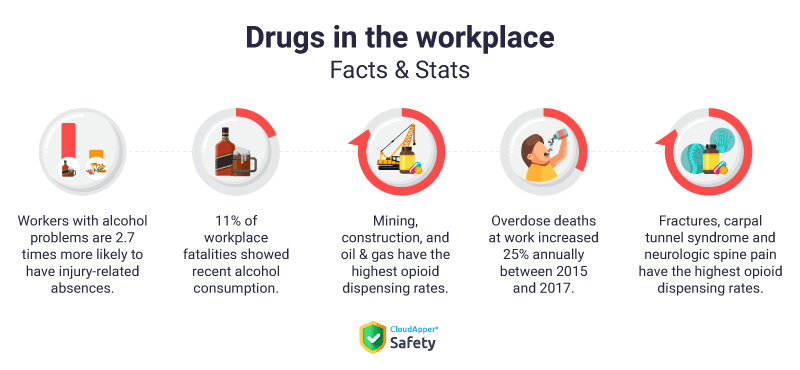Table of Contents
In the workplace, drugs are becoming more and more of a factor in unsafe behavior. The United States is experiencing an opioid epidemic, with the United Kingdom having the greatest opioid consumption in Europe. Employers and EHS managers, on the other hand, can assist in the eradication of drugs in the workplace, resulting in a healthy and safe working environment.
This blog post discusses how drugs in the workplace affect workplace safety, as well as how to recognize drug usage and promote a drug-free workplace. Let’s get started.
Statistics on Drugs in the Workplace
The United States is currently in a state of an opioid crisis. In 2017, an estimated 1.7 million people in the United States misused prescription opioids, with 47,600 people dying from overdoses.
In total, about 21 million Americans abuse substances, with roughly three-quarters of them working. Prescription painkillers for job injuries can sometimes lead to addiction.
Furthermore, people with drug abuse disorders miss up to 50% more days at work than their colleagues, resulting in reduced productivity.
Here are some more statistics on workplace drug use.

Drugs in the Workplace and Safety
Opioid, alcohol, and other substance abuse are not to be taken lightly. Unfortunately, in addition to overdosing, drugs in the workplace pose a threat to workers’ safety.
Workers under the effect of drugs, for example, have lesser awareness and inhibitions. Drugs slow reaction times and make people more likely to act violently. There’s also the possibility of making poor decisions and taking unnecessary risks, which are two of the most typical side effects of using drugs at work.
All of these behaviors, most significantly, endanger worker safety.
Consider car accidents as an example. In 2016, 44 percent of fatally injured drivers tested positive for drugs, according to GHSA. Marijuana, opioids, or a combination of the two were found in the systems of more than half of the drug-affected drivers. To be clear, these figures indicate an increase in drug usage across the country, as well as the dangers it poses to our health.
Even if drugs aren’t used in the workplace, they still pose a risk. Drug after- and side-effects (hangover and withdrawal symptoms) have an affect on job performance as well.
How Can EHS Managers Spot Drugs in the Workplace
Prescription opioids have strong side effects, including:
- withdrawal
- constipation
- changes to brain chemistry
- nausea
- respiratory depression
- increased pain sensitivity
- driving impairment
But how can you spot drug use in the workplace?
Well, the biggest giveaway is behaviour changes. The most common include:
- irritableness,
- poor concentration,
- loss of motivation,
- poor personal hygiene,
- sweaty palms and shaky hands,
- red, watery eyes, and
- frequent bathroom breaks.
In other words, if a worker shows certain behaviors, drugs may be to blame. Furthermore, the HSE advises employers to keep an eye out for the following warning signs:
- unexplained and frequent absences
- productivity lapses
- increase in accidents and near misses
- performance or conduct issues
The Battle of EHS Managers Against Drugs in the Workplace
Prescription opioids can lead to drug addiction. In fact, four out of every five persons who develop a heroin addiction started by abusing prescription opioids.
Prescription opioids are commonly recommended for pain management, making injured employees vulnerable to drug overdoses. Furthermore, for wounded employees, melancholy, sleep apnea, obesity, and COPD can develop, increasing the risk of overdosing.
Nevertheless, there are steps employers can take to curb drugs in the workplace:
- Educate employees on the risks of substance abuse
- Implement drug testing
- Provide support services and wellness programs
- Encourage safe behaviour across departments
- Implement drug-free workplace policies
Employers can also provide services and programs to help employees who are struggling with alcohol and drug abuse or other health issues.
For example, the Employee Assistance Program provides short-term counseling, assessment, and referral for employees who are struggling with alcohol and drug misuse, mental health issues, financial issues, or any other issues that are interfering with their work. Employees may find it easier to come up about their concerns if they have access to external counsellors.
Small businesses, on the other hand, may find it more difficult to implement these initiatives. Drug-free workplace rules, on the other hand, have a number of advantages, including enhanced productivity and employee longevity. These techniques will also cut down on wasted time and healthcare costs.
Testing for drugs and alcohol
Drug testing is an effective way to ensure that your workplace is drug-free. Workers, on the other hand, may feel betrayed as a result. To combat this, establish a clear workplace drug policy that explains why drug testing is necessary for employee safety.
Employers in both the commercial and public sectors are legally permitted to test their employees. Drug testing is a legal requirement in several businesses, such as those that involve operating heavy machinery.
Workplace rules for substance addiction are governed by federal and state regulations in the United States.
EHS Managers’ action against risky behavior
Changing human behavior is difficult, and some things are beyond our control. However, drugs in the workplace, as well as their associated risky behaviors, can be removed.
Prescription painkillers, illegal drugs, and alcohol have all been linked to unsafe behavior. The use of drugs in the workplace is at an all-time high, with opioid medications putting many workers at risk of addiction.
Worker drug-free policies send a strong message that workplace safety comes first. However, even if medicines are used outside of working hours, their side effects might pose problems in the workplace. As a result, companies must take steps to address the known (controllable) root cause of workplace events and injuries.
These activities have the potential to make a major difference in the lives of persons who are battling with addiction.
If employers refuse to allow drugs in the workplace, employees (70 percent of the 14.8 million employed drug users) must refuse as well. Above all, EHS managers have a critical role in combating the opioid problem, and their actions can have a big impact.
Organizations can help to ease the national crisis and protect their employees by tackling substance misuse in the workplace. Employers might also expect an increase in incidence rates, productivity, and a safer workplace culture.
What is CloudApper AI Platform?
CloudApper AI is an advanced platform that enables organizations to integrate AI into their existing enterprise systems effortlessly, without the need for technical expertise, costly development, or upgrading the underlying infrastructure. By transforming legacy systems into AI-capable solutions, CloudApper allows companies to harness the power of Generative AI quickly and efficiently. This approach has been successfully implemented with leading systems like UKG, Workday, Oracle, Paradox, Amazon AWS Bedrock and can be applied across various industries, helping businesses enhance productivity, automate processes, and gain deeper insights without the usual complexities. With CloudApper AI, you can start experiencing the transformative benefits of AI today. Learn More























